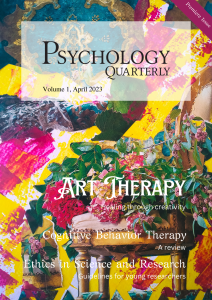Art Therapy
Life can be messy. Not everything is in its place. Not everything is planned. Life is like art. Art for the sake of art is unplanned. The productivity comes from within – maybe through a ‘soul’. I hesitate to say soul because psychology students are normally taught they are learning a scientific discipline. The soul has no place in science. But counseling is not a science. It is an art. 'Messy' and 'unplanned' are two things that counseling tolerates one hundred percent. Counseling talks to the soul, and out of the soul comes art. Messy and unplanned art that speaks of the soul. Art is one way of knowing your soul, and who you are.
But we must not use the word ‘art’ to mean an end product. Rather, what we mean is ‘image making’. Many people are discouraged when they hear ‘art therapy' because they believe it will be useless as they are not artistic or talented in that way. But images are not necessarily the end product. Images are with us all the time, even when we sleep; there are images in our dreams! Making images is freeing yourself from everything you are restricted by. It is the freedom of new ideas and new points of view. At certain times in history, we have used art to create culture – through folk art. Folk artists were ordinary people, and their creativity was not commercialized. Creating folk art was part of their culture, where their daily lives were surrounded by depictions in art form in religious places, on gravestones, and even on home exteriors.


We create images with our imagination. And imagination resides deep within us. Do we have a good relationship with our imagination? These days, hardly. We are never bored enough to daydream and let our imaginations run wild. We prefer to swipe. Either on a device or doing some activity. We have become afraid of having nothing to do. Art therapy slows us down and helps us reconnect with our imagination. Probe the darkest places to bring out our true beliefs. Dr. Bernie Siegel realized that the imagery produced by patients highlighted their beliefs about healing or treatment. In his book, "Love, Medicine and Miracles", Dr. Siegel describes how his patients tell him their inner beliefs about treatment through their drawings. They might say verbally that the treatment is going very well, but deep within, they might believe chemotherapy is poison. If the patient reacts as if they have been poisoned, the treatment must be stopped. Dr. Siegel goes on to explain that once this inner belief is revealed through a drawing, the attitude can be changed. That is because now the belief is out there in consciousness, and thus it becomes easier to deal with.
Although my way of conducting art therapy is somewhat unorthodox, I believe it is necessary to give counseling students a theoretical base to the form of art therapy that has evolved into a professional therapeutic modality. Our clients come from various backgrounds and belief systems. Each one is unique in his/her own way. Judith A Rubin says in her "Approaches to Art Therapy Theory and Techniques", that it is important for us to be familiar with various theories of how people grow. It helps us to understand a client's worldview through a variety of lenses, giving us better insight on how best to serve our them. Keeping this in mind, we will offer lessons in art therapy, beginning with an introduction that will consider it from the viewpoints of psychodynamic approaches, Jungian analytical psychology, and person-centered approach. The lessons, techniques, and historical background will help you step onto a more holistic path in your counseling practice.
To access these lessons, please subscribe to the magazine. All counseling and psychology lessons (including art therapy lessons) will be available only through the printed version of the magazine which will be delivered to your door (within Sri Lanka). Overseas subscribers, please get in touch with us at info@psychologyquarterly.com to get a quote for shipping cost and seperate payment link.
The following lessons are available in the first edition of Psychology Quarterly magazine:
- A brief history of art therapy.
- Discovering your personal story/myth.
- Exploring your imagination with simple meditation practices.
- A starter pack of simple techniques and exercises.
- Introduction to the psychodynamic approaches in art therapy
Art therapy lessons will run in eight consecutive editions of the magazine.


